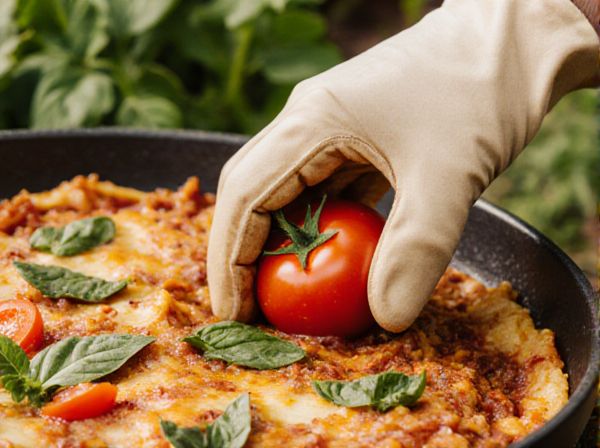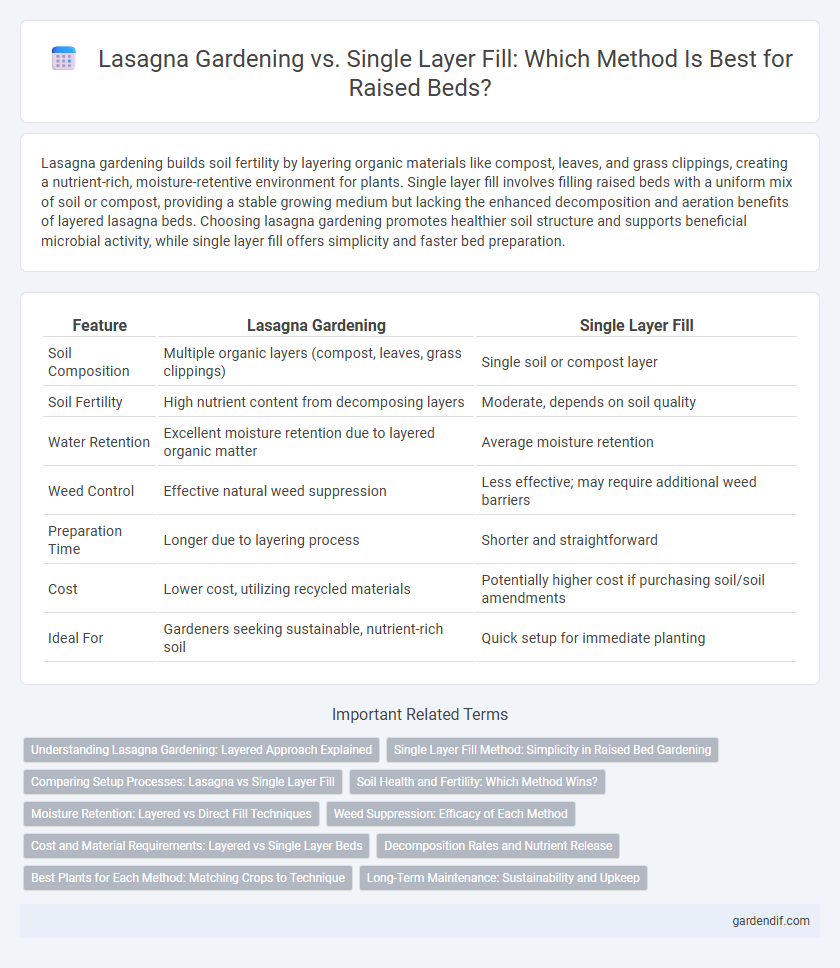
Lasagna Gardening vs Single Layer Fill Illustration
Lasagna gardening builds soil fertility by layering organic materials like compost, leaves, and grass clippings, creating a nutrient-rich, moisture-retentive environment for plants. Single layer fill involves filling raised beds with a uniform mix of soil or compost, providing a stable growing medium but lacking the enhanced decomposition and aeration benefits of layered lasagna beds. Choosing lasagna gardening promotes healthier soil structure and supports beneficial microbial activity, while single layer fill offers simplicity and faster bed preparation.
Table of Comparison
| Feature | Lasagna Gardening | Single Layer Fill |
|---|---|---|
| Soil Composition | Multiple organic layers (compost, leaves, grass clippings) | Single soil or compost layer |
| Soil Fertility | High nutrient content from decomposing layers | Moderate, depends on soil quality |
| Water Retention | Excellent moisture retention due to layered organic matter | Average moisture retention |
| Weed Control | Effective natural weed suppression | Less effective; may require additional weed barriers |
| Preparation Time | Longer due to layering process | Shorter and straightforward |
| Cost | Lower cost, utilizing recycled materials | Potentially higher cost if purchasing soil/soil amendments |
| Ideal For | Gardeners seeking sustainable, nutrient-rich soil | Quick setup for immediate planting |
Understanding Lasagna Gardening: Layered Approach Explained
Lasagna gardening involves creating a raised bed by layering organic materials such as cardboard, compost, straw, and kitchen scraps to build nutrient-rich soil over time. This layered approach promotes soil fertility and moisture retention by mimicking natural decomposition processes, resulting in enhanced plant growth. Unlike single layer fill, lasagna gardening continuously improves soil structure, supports diverse microbial activity, and reduces the need for chemical fertilizers.
Single Layer Fill Method: Simplicity in Raised Bed Gardening
The Single Layer Fill method in raised bed gardening offers simplicity by using a uniform soil mixture, eliminating the need for layering different materials as in lasagna gardening. This approach allows for easier soil preparation and consistent nutrient distribution, promoting healthy root growth and improved plant development. By focusing on a single, well-balanced soil layer, gardeners can save time and effort while maintaining effective soil aeration and moisture retention.
Comparing Setup Processes: Lasagna vs Single Layer Fill
Lasagna gardening involves layering organic materials like leaves, compost, and straw, creating a nutrient-rich, self-multiplying bed that decomposes over time, whereas single layer fill uses one uniform layer of soil or compost, resulting in quicker setup but less long-term soil improvement. The lasagna method requires more initial labor and materials but fosters better moisture retention and soil aeration compared to the straightforward, faster single layer fill. Gardeners choosing between the two should consider whether they prioritize soil health and sustainability or speed and simplicity in their raised bed setup.
Soil Health and Fertility: Which Method Wins?
Lasagna gardening enhances soil health more effectively by layering organic materials that decompose to enrich fertility and promote microbial activity, compared to the single layer fill method which relies on a uniform soil mix with less nutrient diversity. The multiple layers in lasagna gardening improve moisture retention and aeration, supporting robust root development and long-term soil structure improvement. Single layer fills may provide immediate planting convenience but lack the dynamic nutrient cycling found in lasagna gardening, making it less beneficial for sustained soil vitality.
Moisture Retention: Layered vs Direct Fill Techniques
Lasagna gardening uses multiple organic layers such as compost, straw, and leaves, which enhance moisture retention by creating a natural mulch that reduces evaporation and maintains consistent soil hydration. In contrast, single layer fill techniques rely on a homogeneous soil mix that can dry out faster without the insulating benefits of layered materials. The layered approach also promotes better aeration and microbial activity, which supports sustained moisture levels and healthier plant roots.
Weed Suppression: Efficacy of Each Method
Lasagna gardening excels in weed suppression by layering organic materials that decompose and create a dense mulch, preventing weed seeds from germinating effectively. Single layer fill provides minimal coverage and often requires additional mulching to inhibit weed growth, making it less efficient in long-term weed control. Studies show lasagna gardening reduces weed infiltration by up to 70% compared to single layer fill methods.
Cost and Material Requirements: Layered vs Single Layer Beds
Lasagna gardening requires multiple layers of organic materials such as cardboard, compost, straw, and kitchen scraps, which can increase initial material costs but promotes rich soil development and water retention. In contrast, single layer fill beds use a uniform mix of soil and compost, reducing upfront material complexity and expenses but may require more frequent amendments to maintain fertility. The cost-effectiveness of each method depends on material availability and long-term soil health goals.
Decomposition Rates and Nutrient Release
Lasagna gardening, with its multiple layers of organic material including kitchen scraps, leaves, and compost, promotes faster decomposition rates due to enhanced microbial activity and better aeration. This accelerated breakdown results in a more gradual and sustained nutrient release compared to single layer fill methods, which tend to decompose slower and release nutrients in a less balanced manner. Consequently, lasagna gardening supports healthier soil structure and improved plant growth through consistent nutrient availability over time.
Best Plants for Each Method: Matching Crops to Technique
Lasagna gardening suits deep-rooted, nutrient-demanding plants like tomatoes, peppers, and carrots, benefiting from its layered organic matter that enhances soil fertility and moisture retention. Single-layer fill works best for shallow-rooted or fast-growing crops such as lettuce, radishes, and herbs, providing quick access to nutrients in the uniform soil mix. Matching crops to each method optimizes growth by aligning plant root structures and nutrient needs with the specific soil profile and aeration characteristics of the raised bed technique.
Long-Term Maintenance: Sustainability and Upkeep
Lasagna gardening enhances long-term sustainability by layering organic materials that decompose slowly, enriching soil fertility and reducing the need for frequent amendments. Single layer fill requires more regular replenishment and soil conditioning to maintain nutrient levels and structure. Over time, lasagna gardening promotes healthier soil ecosystems, minimizing upkeep and supporting resilient plant growth.
Lasagna Gardening vs Single Layer Fill Infographic

 gardendif.com
gardendif.com